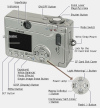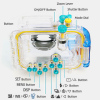

|
|
Digital Cameras
My Camera - Canon IXUS v3I have been using a Canon IXUS V3 which is I purchased at the end of 2002 so I have been using it for a number of years now. Here are some pictures of the camera -
 And here are some photographs of the camera's waterproof case which is the main reason I purchased this camera - 
 And here are the most important camera specifications -
(W) wide angle, (T) telephoto
Back to Top Why did I choose this digital camera?The main reasons I selected this camera are listed below -1. Firstly, it was one of the few cameras which had an optional waterproof case. The waterproof camera case cost me approx AUS $300 which was pricey but certainly more affordable than the professional underwater camera cases on the market which often cost thousands of dollars. 2. Second, I had seen samples of photos taken with this digital camera on the Canon (Japan) website. I was very impressed with the quality of the sample images. 3. The Canon (Japan) website also had a lot of detailed information about using the Canon digital cameras for underwater photography. 4. The camera was capable of making short videos at a resolution of 640 by 480 (i.e. 640 pixels wide and 480 pixels high) which was a very high resolution compared to other digital camera on the market at the time. Back to Top My results - Still photosI have taken some photos with this camera that I am very happy with. Here is a few sample photos -






Back to Top My results - VideosI have included some screen captures of the video when shot at the highest resolution of 640 by 480 -




Back to Top What I have learned about using digital cameras
Back to Top What features would I be looking for in a new camera?Here are some of the features I would be looking for in a new digital camera -
Copyright Notice: The videos and images displayed on this page are protected by copyright. Back to Top |